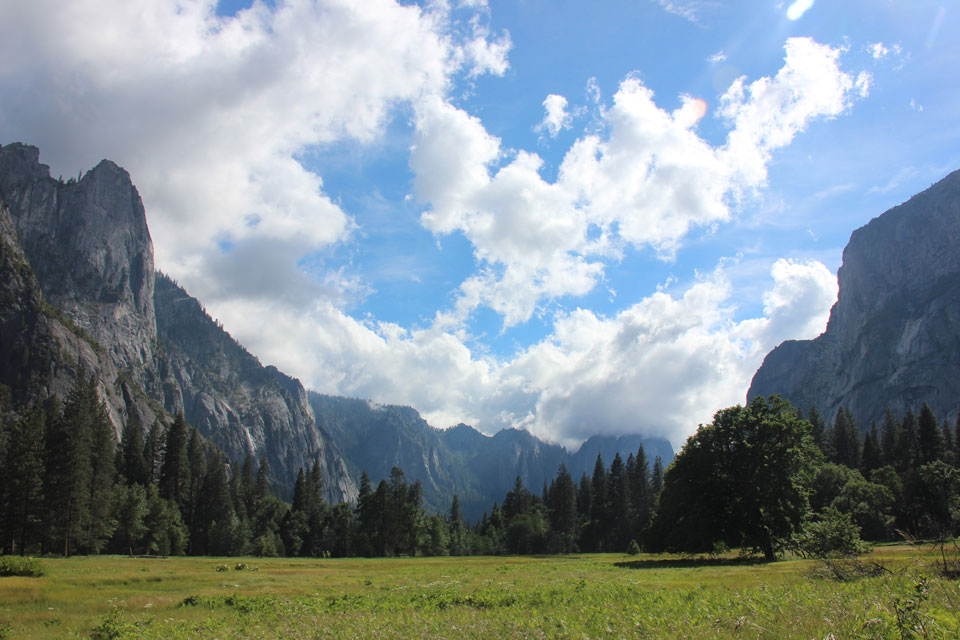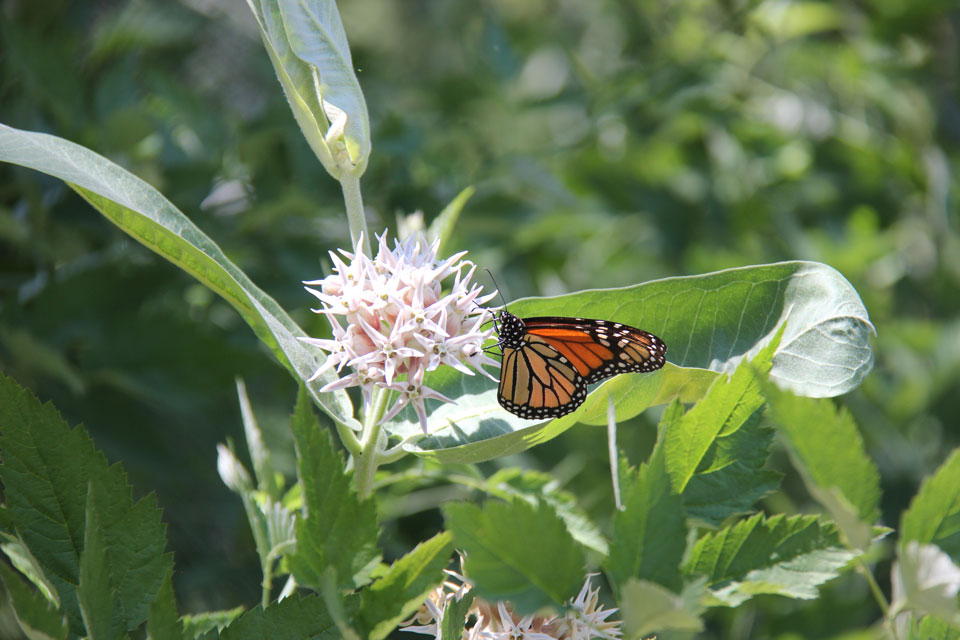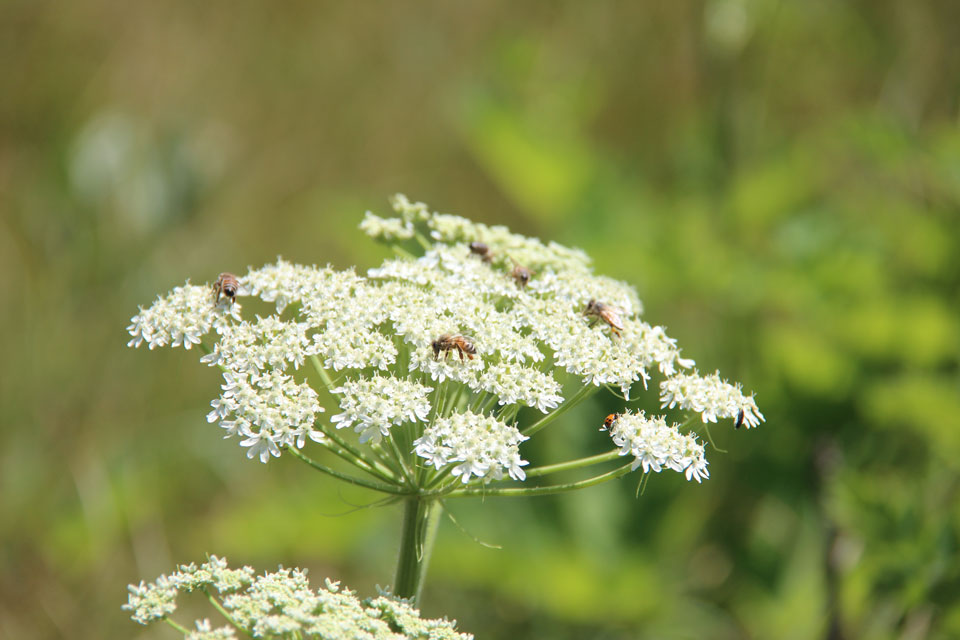Being a ranger is sometimes like being the deer in the meadow. Even though I wear a flat hat and don’t sport big ears, I know I’m immediately visible. We’re part of the landscape, but the best part about encountering a ranger on the trail is we can talk back (and we’ll have more to say than what kinds of sedges are good to eat). At least once a week I take a walk through Cook’s Meadow since it’s so close to the visitor center. Not unlike my deer colleagues, I stroll through the meadow in search of something. As John Muir once said, “In every walk with nature one receives far more than he seeks.” It’s a sentiment I can certainly believe in when I walk out on the creaking boardwalk.

“Hey Ranger! What are you doing?” A visitor may ask.
“I’m watching and waiting.” I reply.
“For what?”
“For Yosemite to share something special. Let me teach you how to think like a ranger. It’s all about looking closely.”
A butterfly flutters past the end of my nose and the whirring of a dragonfly’s wings at high speeds can be heard just over my shoulder. A red-winged blackbird makes a trilling call and a red-shouldered hawk cries out a warning to chattering Steller’s jays. High above, Half Dome looks down from the east. There’s Yosemite Falls to the north. Sentinel Rock to the south and the Three Brothers to the west. The Merced River can be heard gurgling along its path. The boardwalk groans a little beneath my boots.
Everyone who travels through the east end of Yosemite Valley has seen this place. At first glimpse, Cook’s Meadow may be an unassuming open space. Green, a few flowers, a path meandering through grasses and a few trees. It’s name is a little curious, who was Cook anyway?
It was named for the Cook family, prominent business owners in Yosemite and nearby communities in the late 1800s. J.J. Cook traveled to the Yosemite area from New York around the start of the Civil War with his wife, Fannie Bruce Cook. Fannie’s sister, Jean, married Henry Washburn and, through this connection, Cook was in business with the enterprising Washburn brothers. Along with his son, J.B., Cook was part of managing the Wawona Hotel, Black’s Hotel, and the Stoneman Lodge. Fannie Cook and her sister wrote and published poetry promoting Yosemite. From the past to the present, this meadow has been a place where people gathered.
And humans aren’t the only ones who hang out there.
When someone walks into Cook’s Meadow the first action is to look up. It’s hard not to develop “Yosemite valley neck” in a place like this. After all, the granite cliffs are pretty amazing. The same forces that carved and shaped those cliffs, spires, and domes created the flat foundation of the meadow. The sediment was chipped off bit by bit over glacial periods and rockfalls to end up at the bottom of the valley. When water slides off the high country, it also filters below the ground, creating the wet conditions that allow the meadow community to thrive. Without that foundation of rich sediment capturing organic materials to create soil, there wouldn’t be much in the meadow at all. The clues are all around, it just takes knowing where to look.
From the center of the boardwalk path, Half Dome dominates the view to the east, framed by black oaks, incense cedars, and ponderosa pines. The trees are youths compared to the granite of Yosemite, but many have been there long enough to see the dramatic human shifts over the past several hundred years. The black oak’s presence, in particular - and the lone apple tree that still stands from an orchard - share a tale of people from the past and present. The oak trees are a part of life for the Ahwahneechee people and also support a thriving community of animal species.
In the shade of the oaks, a raucous “wakka, wakka, wakka” sounds from the upper branches accompanied by the flash of a black and white bird. A few more speedy feathered bodies follow, repeating the call. The acorn woodpeckers are often described as clowns for their white faces and yellow eyes. They may look comical, but they are very social birds with complex, multi-generational families. It’s easy to watch their progress through the canopy and find hints to where they keep their acorn stash. A tree with hundreds of holes drilled into it is usually the work of the acorn woodpecker. They stuff those hollows full of food for the winter.
Continuing through the meadow, a small brown bird chases after a dragonfly, beak agape. It’s one of the many species of flycatcher that hunts flying insects as they skim the water or browse from flower to flower. With specialized feathers around their bills, these birds have a built in bug net that funnels the food right into their mouths.

Their darting prey and relatives can be found everywhere you turn. From monarch butterflies to flame skimmers, the meadow is awash in invertebrate color. Yosemite has hundreds of species of butterfly alone and many of them can be glimpsed in this meadow between Southside and Northside Drives.
The only way to catch a glimpse of the glossy blue milkweed beetle or the delicate thread-waisted digger wasp is to get out of the car, out of the road, and down the path. Looking closely is a skill that never ceases to bring a discovery.

On the white umbel of a cow parsnip is a bee fly, using its mimicked colors to avoid predators. Crawling up the stalk is an adult California glowworm identified by the pink dots to either side of the beetle’s head. Hanging out on a nearby fringed leaf is a two-spotted lady-beetle waiting for its own prey of even smaller invertebrates. A California ground squirrel scurries through the underbrush from one place to another. A western fence lizard gets out of its way, startled, moving to a quieter spot to warm itself in the sun. Each plant offers up a new world to discover and the best part is there are hundreds in this meadow alone!
To see it, all it takes is slowing down and thinking like a ranger.
Learn to take a closer look. Go on a walk on the meadow trail. Look up, down, and all around.
You might be amazed at what you can see.
